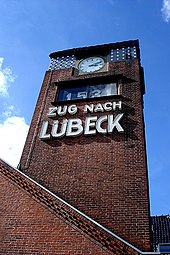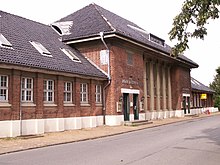Railway line Lübeck – Lübeck-Travemünde Strand
| Lübeck – Lübeck-Travemünde beach | |||||||||||||||||||||||||||||||||||||||||||||||||||||||||||||||||||||||||||||||||||||||||||||||||||||
|---|---|---|---|---|---|---|---|---|---|---|---|---|---|---|---|---|---|---|---|---|---|---|---|---|---|---|---|---|---|---|---|---|---|---|---|---|---|---|---|---|---|---|---|---|---|---|---|---|---|---|---|---|---|---|---|---|---|---|---|---|---|---|---|---|---|---|---|---|---|---|---|---|---|---|---|---|---|---|---|---|---|---|---|---|---|---|---|---|---|---|---|---|---|---|---|---|---|---|---|---|---|
| Route number : | 1100, 1113, 1115, 1117 | ||||||||||||||||||||||||||||||||||||||||||||||||||||||||||||||||||||||||||||||||||||||||||||||||||||
| Course book section (DB) : | 104 | ||||||||||||||||||||||||||||||||||||||||||||||||||||||||||||||||||||||||||||||||||||||||||||||||||||
| Route length: | 20.311 km | ||||||||||||||||||||||||||||||||||||||||||||||||||||||||||||||||||||||||||||||||||||||||||||||||||||
| Gauge : | 1435 mm ( standard gauge ) | ||||||||||||||||||||||||||||||||||||||||||||||||||||||||||||||||||||||||||||||||||||||||||||||||||||
| Power system : | Overhead line 15 kV 16.7 Hz ~ | ||||||||||||||||||||||||||||||||||||||||||||||||||||||||||||||||||||||||||||||||||||||||||||||||||||
| Top speed: | 120 km / h | ||||||||||||||||||||||||||||||||||||||||||||||||||||||||||||||||||||||||||||||||||||||||||||||||||||
| Dual track : | Schwartau Waldhalle – Üst Lübeck-Kücknitz junction | ||||||||||||||||||||||||||||||||||||||||||||||||||||||||||||||||||||||||||||||||||||||||||||||||||||
|
|||||||||||||||||||||||||||||||||||||||||||||||||||||||||||||||||||||||||||||||||||||||||||||||||||||
The Lübeck – Lübeck-Travemünde Strand railway line is a partially double-track, electrified railway line in Schleswig-Holstein . It mainly serves the feeder traffic to the Travemünde Baltic Sea beach and to the Baltic Sea ferries at the Skandinavienkai as well as the inner-city traffic in Lübeck .
route
Route description

The Lübeck – Lübeck-Travemünde Strand railway leaves Lübeck Central Station to the north together with the Vogelfluglinie and the Kiel – Lübeck railway line . Shortly before reaching the Bad Schwartau train station , the route branches off to the east and runs directly on the left bank of the Trave to Lübeck-Dänischburg . Then a freight line of the Lübeck port railway branches off to the container terminal of the Lehmann company and to the Seelandkai of the Lübeck port company . After crossing the motorway A 226 and B75 follows the breakpoint Lübeck-Kücknitz the branch for KV -Terminal Baltic Rail Gate at Travemuende Skandinavienkai. The route then runs alongside the Travemünder Landstrasse and then along the port border of the Skandinavienkai. The Lübeck-Travemünde Skandinavienkai stop on the northern edge of the quayside also serves the residential area of the Pomerania Center on Rönnauer Weg. After reaching the Travemünde urban area, after a level crossing over the busy Gneversdorfer Weg, the Lübeck-Travemünde Hafen train station follows near the town center. There used to be a branch here via Brodten to Niendorf (Baltic Sea) . The end of the route is the Lübeck-Travemünde Strand terminus station , which is located in the spa district.
Route numbers
The section Lübeck Hauptbahnhof – Schwartau Wr branch bears the route number 1100. The route to Lübeck-Travemünde Strand used by passenger traffic has the number 1113, while the route used by freight traffic to the Lehmann container terminal and the LHG -Seelandkai in Herrenwyk (formerly: to the blast furnace plant Lübeck ) as well as to the Skandinavienkai have the route numbers 1115 and 1117.
history

The line was opened on August 1, 1882 under Walther Brecht , director of the Lübeck-Büchener-Eisenbahn-Gesellschaft (LBE), and extended on July 1, 1898 from today's Lübeck-Travemünde Hafen station to Lübeck-Travemünde Strand. The rapidly growing excursion traffic to Travemünde required a new beach station in 1911, which was built in Art Nouveau according to plans by Fritz Klingholz . As a special feature, it received a clock tower that is visible up to the beach and shows the departure time of the next train to Lübeck Hauptbahnhof on a large display.
In 1913, an almost five-kilometer branch line from Lübeck-Travemünde Hafen to Niendorf (Baltic Sea) was built to make this place more accessible for tourists.
Until the nationalization by the Deutsche Reichsbahn on January 1, 1938, responsibility for operations was transferred from the LBE to them. The LBE, which used high-quality double - decker cars as early as the 1930s , introduced the striking advertising slogan "Hamburg, Lübeck, Travemünde - From the sea of houses to the sea".
Before the Second World War , the line was under the sovereignty of the Reichsbahndirektion Schwerin . The Deutsche Bundesbahn later took over operations.
On September 29, 1974, the line between Lübeck-Travemünde Hafen and Niendorf was closed. In the 1990s, the Schwartau-Waldhalle stop was closed.
In 2004, the Lübeck-Travemünde Skandinavienkai stop was set up near the ferry terminal to Sweden and Finland , as the port station previously used for ferry traffic was too far away. In 2006–2007, however, the Skandinavienkai was expanded on a large scale to include port areas and industrial areas for companies and logistics companies near the port. For this purpose, in 2005 the railway line had to be relocated several hundred meters westwards over a length of one and a half kilometers, so that it now runs alongside Ivendorfer Landstrasse. In addition, a new building for the port terminal was erected about one kilometer south of the demolished old one. This means that the new stop no longer has walking access to the Skandinavienkai. Passengers arriving by train will have to transfer to the bus to reach the ships.
On May 23, 2006, after extensive restoration work, the newly designed historic beach station was reopened. In this context, the previously defective tower clock was put back into operation. In April 2016, the display was out of service again. It was repaired by July 2016.
In 2007, work began to electrify the line as a continuation of the Hamburg – Lübeck railway line. The electrification was completed in December 2008. Since then, freight trains have been traveling to the Hamburg area without changing locomotives.
In July 2010 the double-track expansion section between Schwartau-Waldhalle and Kücknitz was put into operation; four bridges had to be rebuilt for this.
Since December 14, 2014, Dänischburg station has been operated again under the name "Lübeck-Dänischburg IKEA"; at DB Netz the station is still run as "Lübeck-Dänischburg". The stop, which was given up in 1986 after the closing of the Villeroy - & - Boch plant, was reactivated after the LUV-Center shopping center with 400,000 m² of retail space had been built on the previous plant site. The renaming goes back to the fact that the IKEA furniture store located in the shopping center took over the entire cost of the construction work with around five million euros.
Vehicle use
From May 1936, the LBE began using streamlined express trains with double-decker cars on the Hamburg Hauptbahnhof – Lübeck – Travemünde Strand route, which caused a worldwide sensation. Back then, they were already equipped as push-pull trains with control cars , automatic Scharfenberg couplings and two-person units with a shared Jakobs bogie . The eight double-deck cars were supplied by WUMAG and Linke-Hofmann . A high-speed tender steam locomotive with streamlined cladding that could be remotely controlled by the driver from the other end of the train was used with the train as planned.
The LBE double-decker coaches offered great comfort for the time, for example padded seats in 3rd class. Larger luggage was received by bellboys when boarding , stowed in the luggage compartment and delivered again when leaving the car.
Especially in the 1960s and 1970s, the German Federal Railroad used push- pull trains hauled by DB class V 200.0 in regional transport to Hamburg . In local transport to Lübeck long time diesel locomotives of the DB Class V 100 with three-axis conversion vans with Eilzugsteuerwagen the type Eilzugwagen used.
In passenger traffic until the start of electrical operation on 13/14. December 2008 diesel locomotives were used. On the summer weekends, up to seven-car double-decker push-pull trains with diesel locomotives of the DB class 218 were used. During the period of low demand, the trains were driven by DB class 628 diesel multiple units. With electrification, class 112 locomotives replaced diesel locomotives.
Freight traffic was carried out with diesel locomotives of the DB class 232 .
The connection is currently (as of 2020) served by the Schleswig-Holstein regional train on weekdays every hour with regional trains on the RB 86 line, which run between Lübeck Hbf and Lübeck-Travemünde Strand and are operated with the 648 series . In the summer half-year, on weekends and public holidays as well as during the Travemünde Week, locomotive-hauled Regional Express trains on the RE 8 line run from Hamburg Hbf via Lübeck Hbf to Lübeck-Travemünde Strand.
Web links
Individual evidence
- ↑ Project: Historical train departure indicator at Travemünde Strand station
- ^ German Bundestag (ed.): Transport investment report for the reporting year 2011 . Informed by the Federal Government (= printed matter . No. 17/12230 ). Bundesanzeiger Verlagsgesellschaft mbH, January 25, 2013, ISSN 0722-8333 , p. 121–122 ( PDF [accessed February 14, 2013]).
- ↑ List of operating locations, as of 2018 , accessed on October 4, 2018
- ^ Schleswig-Holstein Landtag: reactivation of railway lines in Schleswig-Holstein. Answer of the state government to the small question of the deputy Christopher Vogt (FDP). Landtag printed paper 18/2663 of February 6, 2015. Online at kleineanfragen.de.








